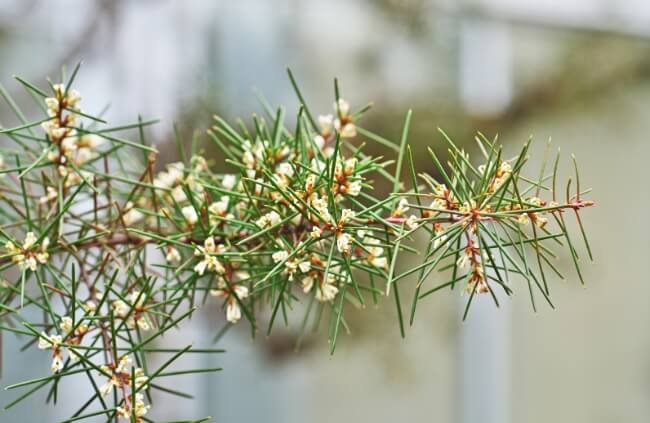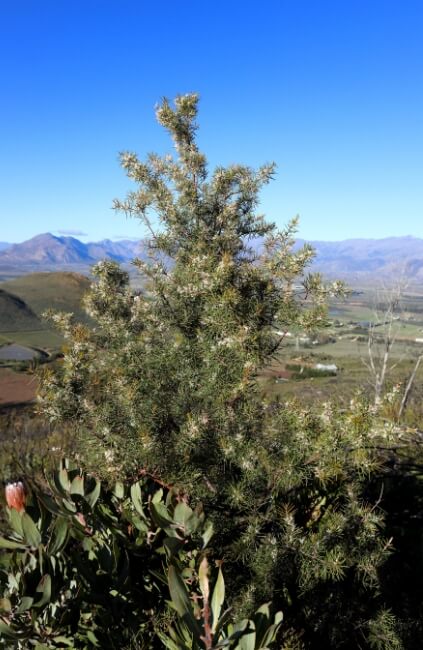Dusty green needle-like leaves and a bountiful showing of highly scented winter flowers make the native Hakea sericea an exceptionally useful garden plant. It is not the most striking shrub, but it Is definitely one of our most useful natives and can be grown fairly well in most parts of Australia.
This guide compiles fact sheets and expert tips for growing Hakea sericea from seed, cuttings and young plants, to make the most of these naturalistic shrubs in any space.
More...

Family: | Proteaceae |
|---|---|
Genus: | Hakea |
Species: | H. sericea |
Common Names: | Silky hakea, bushy needlewood |
Origin: | Eastern Australia |
Location: | Outdoor |
Type: | Large shrub |
Growth: | 7 m tall |
Sun requirements: | Full sun |
Foliage Colour: | Green |
Flower Colour: | Pink/White |
Flowering: | Winter |
Edible Parts: | None |
Maintenance level: | Low |
Poisonous for pets: | Non-toxic to cats and dogs |
What is Hakea sericea?
Hakea sericea is a large shrub, reaching 5-7 m tall in most conditions. It readily self-seeds in southeastern Australia, but is much easier to control in other parts of the country.
Common names for Hakea sericea include the Silky Hakea and Bushy Needlewood, due to its spiny, needle-like leaves. Profusions of curled flowers fill the previous year’s growth in mid-winter, filling gardens with the sweet perfume of rich warmed honey.
Its fragrance is particularly noticeable between sunrise and midday, making it a perfect pick-me-up in a winter garden.
Silky Hakea’s Natural Habitat
Hakea sericea is native to the east coast of New South Wales, where it thrives in humid salty conditions, and has naturalised across the south coast of Victoria, where it can be seen growing in swathes across open landscapes as far as Adelaide in South Australia.
Silky hakea is frost tolerant (also found growing wild in Northern Tasmania) provided it is growing in well-drained conditions, with full sun. Seeds germinate best following fire, but the pods are well known for exploding and sending seeds far and wide, meaning germination occurs quite randomly in good conditions.
How to Grow Hakea sericea

Hakea sericea prefers rich, well-worked soils, and will grow significantly stronger if treated with care. However, Hakea sericea will perform in poor soil, heavy soils, and loose sandy soils, and is reasonably drought tolerant too.
If you ever want to truly understand what proper care can do for plants, or why ‘right plant, right place’ really matters as a gardening mantra, Hakea sericea will demonstrate it perfectly.
With differences in growth habits, nectar production, branch strength, and growth rate, Hakea might survive in a typical garden, but it will only thrive with your help.
Planting Silky Hakea
Hakea sericea is usually sold in 2L pots, with top growth no more than 30 cm, but you can find more mature species at good nurseries. Over time, they need space to grow into 5 m tall shrubs, which can take as little as seven years in ideal conditions, so provide the space they need.
Work well-rotted horse manure into the soil before planting, and keep some aside for mulching for the first few years after that.
Offer taller plants a stake for the first couple of years, as they can become top-heavy during windy weather and branches are liable to snap. This happens in nature and is likely in gardens, but this natural pruning tends to produce well-shaped plants.
The Best Soil Conditions for Hakea sericea
Hakea sericea will grow in most soils but prefers well-drained soil with plenty of organic matter. Well-rotted manure, with a light, loamy texture, will improve sandy or clay soils. For well-worked garden soil, don’t add anything, but do mulch with organic compost or manure when possible to boost flowering in later years.


Get Your Free Guide:
Master Growing Australian Natives eBook
A Must Have Complete Guide for Every Australian Garden
Get Your Free Guide:
Master Growing Australian Natives eBook
A Must Have Complete Guide for Every Australian Garden
Ideal Light & Temperature
Hakea are sun-loving plants, and the silky hakea is no different. Planted in full sun, in climates with reasonably cool winters, this evergreen shrub will perform at its very best.
Warmer climates tend to cause silky hakeas to flower less, and with lower nectar production, so they are at their best in their native range, where they get more reliable seasonal changes.
Exposure & Wind considerations
Silky hakea will grow well in exposed conditions, but it is liable to break and snap in high winds. This won’t harm the plant, and they generally recover well, with bushier growth as a result.
If you prefer to keep things neat, that is possible too. Just plant Hakea sericea in a slightly sheltered position, and prune back with care each year, making sure to maintain a neat but natural shape. This will reduce breakages, and keep the overall canopy more compact.
Watering Hakea sericea
Hakea sericea is drought tolerant, but tolerant does not mean it likes it. Just because a plant can cope with drought does not mean it’s good for it. Aim to keep the soil at the base of Hakea sericea moist but not too wet throughout summer.
In winter, Hakea can cope with drier conditions and will flower well, but summer droughts will impact flowering (and the fragrance of flowers) more than anything else.
How to Propagate Hakea sericea

Source: CABI Digital Library
The most reliable propagation method for Hakea sericea is from collected seed.
As mentioned earlier, Hakea germinates most reliably after smoke treatment, where the fruits are essentially placed in a low-burning fire to char. There are many ways of doing this, but controlling the heat is important. Following smoke treatment, seeds can be sown as normal.
If you don’t like the sound of harvesting and charring Hakea sericea fruits, don’t worry, it isn’t essential. Hakea sericea have a reliable germination rate of about 50%, so by sowing a few of the winged Hakea seeds, taken from ripe pods on the plant, you will be able to grow your own silky hakea quite easily.
There are no special propagation methods at this stage, just place one seed into an individual 10 cm pot filled with any seed or cutting compost you have; water it; then place it somewhere warm and bright for a few weeks.
Roots are quick to develop on seedlings, and they can usually be planted out into the garden after around six months.
Caring for Hakea sericea
Hakea sericea are tough native plants. They don’t need feeding, watering, or pruning, and can often look better for it. However, for me, the highlight of silky hakeas is their winter scent, and that is boosted exponentially by feeding.
Mulching and feeding Hakea sericea
The best way to feed silky hakea is with rich organic mulches, either annually or biennially depending on your soil (but once every ten years is better than never, so don’t be too prescriptive, just feed them when you can).
Avoid mulching right up to the stem, as this always risks fungal problems and bacterial infections from within the mulch. Leave a 10 cm ring around the base of the plant, and then mulch in a 2-inch layer around the base of the plant.
Mulch in late spring or early summer, or just after flowering each year to boost moisture retention through the warmer months, when it matters most.
Water requirements
Watering offers similar support to mulching your silky hakeas, but is a bit more work for the same results. If you are not a fan of mulches and prefer an even tilth over your borders though, then water whenever the soil is looking dry.
The soil needs to drain, as Hakeas do not like having constantly wet feet, but the more moisture that can pass them by, the better, so water weekly in summer if you are not mulching.

Source: Centre for Invasion Biology
Pruning Hakea sericea
The only complicated part of silky hakea care is pruning. You can be harsh and rigorous, maintaining a standard hedge with neat edges, but it tends to look a little bit naff. Hakea sericea is at its best when its loose needly leaves are firing out from the main body of the plant, ready to add drama to your winter garden.
That means pruning considerately and putting the shears or hedge trimmers away, in exchange for a decent pair of secateurs.
Take your time pruning Hakea sericea. Head out into the garden after flowering, and remove growth from the most recent summer.
Cut carefully back to above a node to encourage regrowth to the same point.
When Hakea sericea reaches its full 7 m height, you can cut back quite hard, but cut each branch back to a node to encourage regrowth, which can be as much as 1 m per year.
Hakea sericea Pests and Diseases
Hakea sericea are generally resistant to pests and diseases in garden settings, but a handful can cause unsightly damage to fruits and flowers, with the most irritating being those that cause bud drop, either through eating the plant, or infecting and preventing the development of scented blooms.
There are three main groups of pests that can damage Hakea, but just a handful of species that seem to cause recurrent issues, or need any treatment. Most common garden pests can be left to their own devices and will not harm the plant.
Moths
Moths, in general, do not pose a threat to Hakea sericea, but the Hakea seed moth (Carposina autologa) is noteworthy. It won’t damage existing plants and poses little threat to established populations of wild Hakea. Rather, it is useful for the control of this potentially invasive weed in other climates.
South Africa has seen the release of the species, specifically to limit the spread of Hakea seeds, as the caterpillars feed on the fruits and developing seeds.
Weevils
Various weevils can cause stem, leaf, and bud damage to Hakes sericea, making them the only truly frustrating garden pest for Hakea growers, as they affect flower production. Encouraging birds into your garden will help to manage large populations of weevils, and limit damage.
Weevils are generally quite obvious on plants and can be shaken off into a jar. Dispose of them how you wish, but I prefer to place them on a bird table. They’re usually gone pretty quickly.
Beetles
Aphanasium austral, the stem-boring beetle, can pose a threat to Hakea sericea, simply because it damages the lower part of the plant. It can be found feeding on both silky hakea and rock hakea (Hakea gibbosa).
Signs are small holes in the main stem or old wood, with piles of sawdust around the bottom of the stem. They can be deterred by wiping neem oil onto the stem, and if the problem persists, spraying neem directly into their bore holes will kill them.
Anthracnose and tip blight or Hakea die back (mostly caused by Pestalotiopsis funerea or Glomerella cingulata) cause generalised growing problems on Hakeas.
Tip blight or die back are characterised by browning leaf tips, and take hold over a matter of weeks, with brown discoloured foliage running from tips, back down to the stem, and eventually to the base of the plant.
If you notice this, or anything similar, it’s worth cutting the damaged material away and burning it to prevent further spread of infection.
Silky Hakea Frequently Asked Questions

Source: ResearchGate
Is Hakea sericea evergreen?
Hakea sericea is an evergreen shrub with needle-like foliage. It holds its leaves reliably through winter, and flowers actively during the coldest months of the year, adding structure and scent to their gardens.
Is Hakea sericea edible?
Hakea sericea is not a useful edible plant, but it is not toxic either. The flowers of Hakea sericea can be infused in cold or hot water to make a sweet drink.
How big are the flowers on Hakea sericea?
Hakea sericea flowers are really quite small, only opening out to about 3 cm each, but they grow in profusions along the stem, giving an elegant and full look during its winter flowering period.
Wrapping Up Our Hakea sericea Guide
It might not be the most visually striking plant, and even when it flowers Hakea sericea is fairly anonymous, but… there are few native plants that can compete with Hakea sericea, the silky hakea, for winter character.
This wonderfully tempting winter-flowering plant offers gardeners something more than the showier grevilleas and banksias we are all used to. It quite literally draws nature into our backyards.
Mature Hakea sericea offers nesting sites for birds, and even the young shrubs produce copious amounts of nectar through winter. Grow Hakea sericea in your own garden this year, and see the benefits for yourself.
Published on January 13, 2025 by Gary Clarke
Last Updated on February 25, 2025




